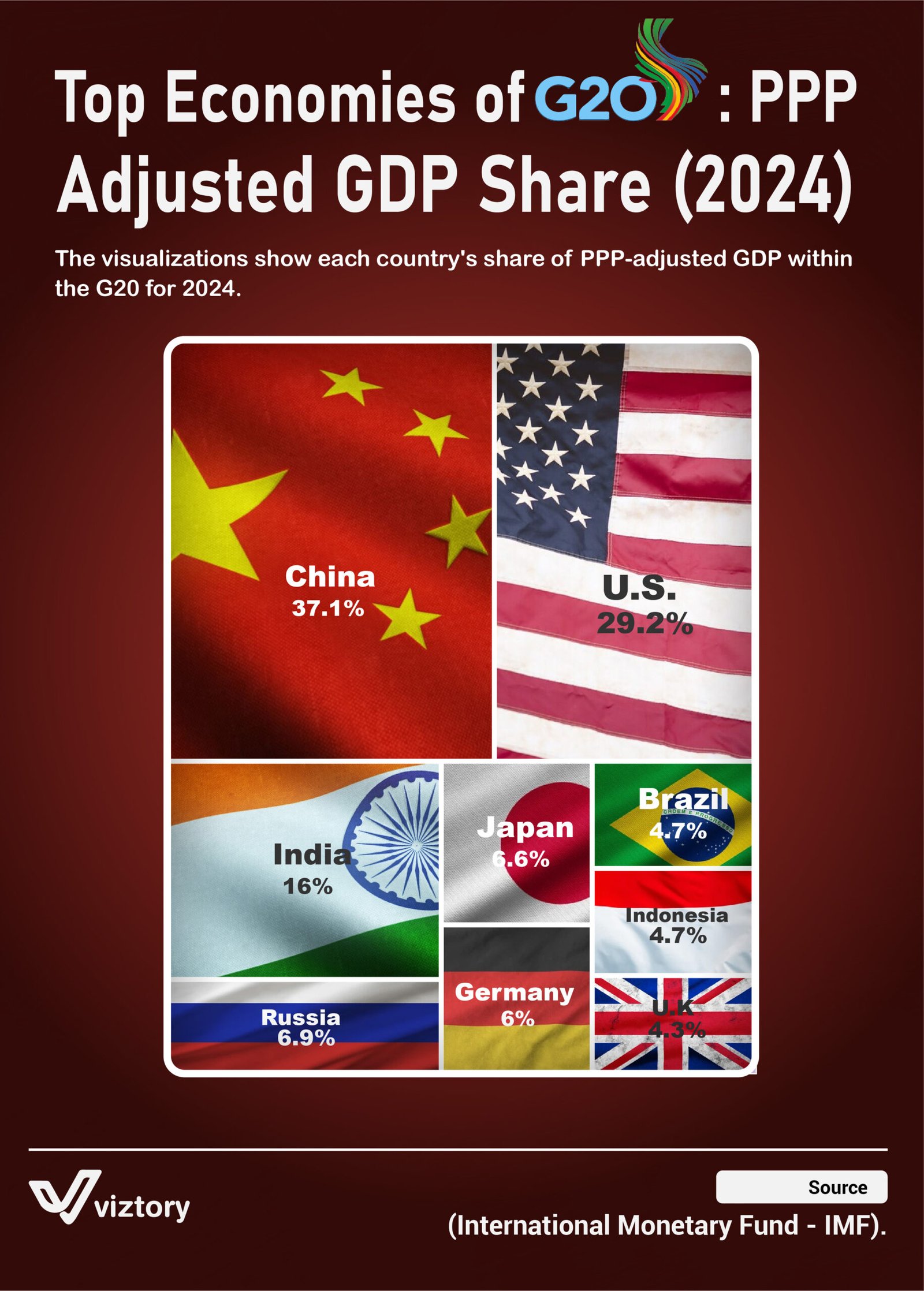Top Economies of G20: PPP-Adjusted GDP Share (2024)
-
Jan, Sat, 2025
The global economy is dominated by the G20 countries, which collectively represent the world’s largest economies. In 2024, the distribution of GDP based on Purchasing Power Parity (PPP) provides a clearer picture of economic influence. This visualization highlights each country’s share of PPP-adjusted GDP within the G20, offering insight into the economic power dynamics and their implications for global finance.
Key Players in the G20 Economy
China (37.1%)
- As the largest economy in the G20 by PPP, China accounts for over one-third of the group’s GDP. Its economic strength stems from its manufacturing base, technological advancements, and growing domestic consumption.
- Financial Implications: China’s dominance impacts global trade, currency exchange rates, and investment flows, making it a central player in international financial institutions.
United States (29.2%)
- The U.S. retains its position as the second-largest economy in the G20. Its diverse economy, driven by technology, finance, and services, remains a global benchmark.
- Financial Implications: As the issuer of the world’s reserve currency (the U.S. dollar), the U.S. has unparalleled influence over global financial markets.
India (16%)
- India’s rapid growth places it third in the G20 by PPP. Its booming tech sector, demographic dividend, and expanding consumer base drive its economic rise.
- Financial Implications: India’s integration into global markets attracts significant foreign investment, particularly in tech and infrastructure.
Russia (6.9%)
- Despite geopolitical challenges, Russia remains a significant player, thanks to its vast energy resources and export-driven economy.
- Financial Implications: Russia’s energy exports heavily influence global energy markets and pricing.
Japan (6.6%)
- Japan’s economy is characterized by advanced technology, manufacturing, and a highly skilled workforce.
- Financial Implications: Japan’s monetary policies and its status as a major creditor nation influence global bond markets.
Germany (6%)
- As Europe’s largest economy, Germany relies on its robust industrial base and exports.
- Financial Implications: Germany’s economic policies shape the European Union’s financial framework, impacting the euro and EU-wide financial regulations.
Brazil (4.7%)
- Brazil’s economy benefits from its agricultural exports, natural resources, and growing industrial sector.
- Financial Implications: As a leader in Latin America, Brazil’s financial decisions impact regional trade and investment.
Indonesia (4.7%)
- Indonesia’s economy is driven by its large population, natural resources, and growing middle class.
- Financial Implications: Indonesia’s role in ASEAN and its strategic trade position influence regional and global financial markets.
United Kingdom (4.3%)
- The UK remains a financial hub, with London playing a pivotal role in global banking and investment.
- Financial Implications: The UK’s financial markets and currency movements affect global financial stability and trade flows.
Financial Insights and Global Implications
Purchasing Power Parity (PPP): Adjusting GDP by PPP provides a more accurate representation of economic influence by accounting for cost-of-living differences and local pricing. This highlights the true economic power of countries like China and India.
Impact on Global Finance:
- Exchange Rates: Economies with higher PPP-adjusted GDP exert greater influence on currency valuation and trade balances.
- Trade Policies: The dominance of specific countries shapes global trade agreements and tariffs.
- Investment Flows: Economic powerhouses attract foreign direct investment (FDI) and drive financial markets.
Shifting Power Dynamics: The rise of emerging economies like India and Indonesia signals a shift in global economic influence, with implications for international financial institutions like the IMF and World Bank.
This visualization underscores the financial weight of G20 economies and the interconnected nature of global markets. As these economies evolve, their policies and growth trajectories will continue to shape the financial landscape for years to come.

